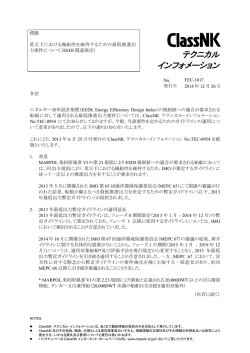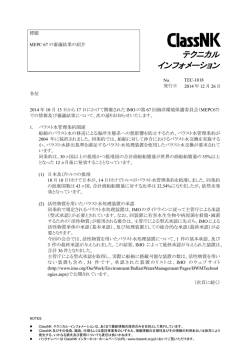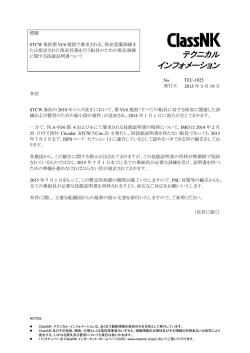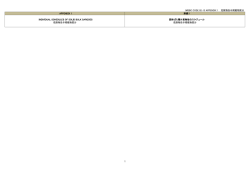
on or after 1 January 2013
Recent IMO movement on International rules and regulations Part 1 Energy efficiency of ships and measures to reducing GHG emission from ships and Air pollution prevention Koichi Yoshida Chairman: IMO working group on Air pollution and Energy efficiency ISO/TC8/SC2 Marine environment protection Energy efficiency of ships and measures to reducing GHG emission from ships エネルギ効率・温室効果ガス排出抑制 • MARPOL Convention ANNEX VI for Energy Efficiency has entered into force 1 January 2013. • Further improvement has been agreed at MEPC65 (May 2013) for Ro-ro ships (Vehicle carriers, cargo ships and passenger ships), LNG carriers and cruise passenger ships, which will be adopted at MEPC66 (March-April 2014( and will enter into force Aug.-Sept. 2015. IMO MEPC adopted on 18 July 2011 Resolution MEPC.203(62) Amendments to the ANNEX of the Protocol of 1997 to amend the International Convention for the Prevention of Pollution from Ships, (inclusion of regulations on energy efficiency for ships in MARPOL Annex VI) The amendment will enter into force on 1 January 2013 to ships 1. For which the building contract is placed on or after 1 January 2013; or 2. In the absence of a building contact, the keel of which is laid or which is at a similar stage of construction on or after 1 July 2013; or 3. The delivery of which is on or after 1 July 2015 This is a break through CBDR and the first global measures for GHG emission reduction without any distinction. Attained EEDI(各船EEDI) Attained EEDI shall be calculated for new ships and ship has undergone a major conversion, which fall into one or more of the categories in regulation 2.25 to 2.35, 2.38 and 2.39 • 2.25 Bulk carrier (exclude combination carrier) • 2.26 Gas carrier other than LNG carrier • 2.27 Tanker (both oil tanker and chemical tanker) • 2.28 Container ship • 2.29 General cargo ship (except livestock carrier, barge carrier, heavy load carrier, yacht carrier nuclear fuel carrier) • 2.30 Refrigerated cargo ship • 2.31 Combination carrier • 2.32 Passenger ship • 2.33 Ro-ro cargo ships (vehicle carrier) • 2.34 Ro-ro cargo ship • 2.35 Ro-ro passenger ship • 2.38 LNG carrier • 2.39 Cruise passenger ship (Regulation applies to the underlined ship type on or after [Aug. - Sept.2015]) MEPC65合意:EEDI exemption 適用除外 • ships not propelled by mechanical means, and platforms including FPSOs and FSUs and drilling rigs, regardless of their propulsion • cargo ships having ice-breaking capability Calculation of attained EEDI n eff n PTI M n eff M n ME fj PME(i ) CFME(i ) SFCME(i ) PAE CFAE SFCAE fj PPTI (i ) feff (i ) PAEeff (i ) CFAE SFCAE feff (i ) Peff (i ) CFME SFCME j 1 i 1 i 1 i 1 j 1 i 1 fi Capacity Vref fw EEDI= CO2 from propulsion system+CO2 from auxiliary -CO2 emission reduction DWT x Speed PME: main engine power (kW) PAE: auxiliary engine power (kW) SFC: Specific fuel consumption (g/kW) C: Fuel to CO2 factor (g Co2/g Fuel) (nearly 3) Capacity: for cargo ships DWT, for passenger ships GT Vref: reference speed (nm/hour) f i: correction factor for capacity f w: correction factor for performance in real weather f j: correction factor for efficiency Guidelines on calculation of attained EEDI were finalized at ISWG-EE2 (Jan. 9 – 13 2012) and adopted at MEPC63 (Feb. 2012), and will be further improved at MEPC66(March-April 2014) for LNG carriers, Ro-ro ships, general cargo ships and cruise passenger ships. Required EEDI (要求EEDI) Attained EEDI ≤Required EEDI=(1-X/100) x reference line value X = reduction factor as below Ship Type Bulk Carrier Gas carriers (other than LNG carriers) Tanker Container ship General Cargo ships Refrigerated cargo carrier Combination carrier Size Phase 0 1 Jan 2013 – 31 Dec 2014 Phase 1 1 Jan 2015 – 31 Dec 2019 Phase 2 1 Jan 2020 – 31 Dec 2024 Phase 3 1 Jan 2025 and onwards 20,000 DWT and above 0 10 20 30 10,000 – 20,000 DWT n/a 0-10* 0-20* 0-30* 10,000 DWT and above 0 10 20 30 2,000 – 10,000 DWT n/a 0-10* 0-20* 0-30* 20,000 DWT and above 0 10 20 30 4,000 – 20,000 DWT n/a 0-10* 0-20* 0-30* 15,000 DWT and above 0 10 20 30 10,000 – 15,000 DWT n/a 0-10* 0-20* 0-30* 15,000 DWT and above 0 10 15 30 3,000 – 15,000 DWT n/a 0-10* 0-15* 0-30* 5,000 DWT and above 0 10 15 30 3,000 – 5,000 DWT n/a 0-10* 0-15* 0-30* 20,000 DWT and above 0 10 20 30 4,000 – 20,000 DWT n/a 0-10* 0-20* 0-30* * Reduction factor to be linearly interpolated between the tow values dependent upon vessel size. Required EEDI(要求EEDI) (2013年5月に合意、2014年4月に採択、2015年8-9月に発効する予定) Ship Type Size Phase 0 1 Jan 2013 – 31 Dec 2014 LNG Carrier 10,000 DWT and above NA 10** 20 30 Ro-ro cargo ships (Vehicle carrier) 10,000 DWT and above NA 5** 15 30 2,000 DWT and above NA 5** 20 30 1,000 – 2,000 DWT NA 0-5* ** 0-20* 0-30* 4,000 GT and above NA 5** 20 30 1,000 – 4,000 GT NA 0-5* ** 0-20* 0-30* 85,000 GT and above NA 5** 20 30 25,000 – 85,000 GT NA 0-5* ** 0-20* 0-30* Ro-ro cargo ships Ro-ro passenger ship Cruise passenger ship*** having non-conventional propulsion Phase 1 1 Jan 2015 – 31 Dec 2019 Phase 2 1 Jan 2020 – 31 Dec 2024 Phase 3 1 Jan 2025 and onwards Reference line value = a x b -c Ship type a b c 2.25 Bulk carrier 961.79 DWT of the ship 0.477 2.26 Gas tanker 1120.00 DWT of the ship 0.456 2.27 Tanker 1218.80 DWT of the ship 0.488 2.28 Container ship 174.22 DWT of the ship 0.201 2.29 General cargo ship 107.48 DWT of the ship 0.216 2.30 Refrigerated cargo carrier 227.01 DWT of the ship 0.244 2.31 Combination carrier 1219.00 DWT of the ship 0.488 (DWT/GT)-0.7・780.36, where DWT/GT<0.3 DWT of the ship 1812.63, where DWT/GT≥0.3 0.471 2.33 Ro-ro cargo ships (vehicle carrier) 2.34 Ro-ro cargo ship 1405.15 DWT of the ship 0.498 2.35 Ro-ro passenger ship 752.16 DWT of the ship 0..381 2.38 LNG carrier 2253.7 DWT of the ship 0.474 2.39 Cruise passenger ship 170.84 GT of the ship 0.241 At the beginning of Phase 1 and at the midpoint of Phase 2, IMO shall review the status of technological developments and, if proven necessary, amend the time period, the EEDI reference parameters for relevant ship types, and reduction rates. EEDI 基準ラインと EEDI の低減目標(要求EEDI値) EEDI Energy Efficiency Design Index for new ships EEDI= 機関出力(kW) x 燃費(g/kW) x 燃料のCO2発生量(gCO2/gFuel) 貨物量(ton) x 輸送距離(海里) EEDIベースライン= a x DWT –c 現存船のEEDI から平均値として算定する EEDI低減値 EEDI要求値 = ベースラインx (1-X/100) X= EEDI低減率(%) Y= 計算 EEDI が要求EEDI以下であることを要求する船舶の大きさ Guidelines on the method of calculation of attained EEDI • MEPC決議212(63) • MEPC64修正(決議224(64)) for shaft motor and shaft generator • MEPC65: 改正討議 • MEPC66 will revise and adopt revised Guidelines on the method of calculation of attained EEDI, which will includes the method for ro-ro cargo ships, LNG carriers and cruise passenger ships. Guidelines on survey and certification of attained EEDI • MEPC63 adopted resolution MEPC 214(63) for guidelines on survey and certification of attained EEDI. • MEPC65 adopted resolution 234(65) for amendments to guidelines on survey and certification – Speed trial and method for obtaining power-speed curve • ISO 15016 to be revised (supported by China, Japan and Korea RO) • ITTC method (supported by Europe, Greek ship owners) 4.3.8 The submitter should develop power curves based on the measured ship speed and the measured output of the main engine at sea trial. For the development of the power curves, the submitter should calibrate the measured ship speed, if necessary, by taking into account the effects of wind, tide, waves, shallow water and displacement in accordance with ITTC Recommended Procedure 7.5-04-01-01.2 Speed and Power Trials, part 2; 2012 revision 1 or ISO 15016:2002*. Upon agreement with the shipowner, the submitter should submit a report on the speed trials including details of the power curve development to the verifier for verification. *ITTC Recommended Procedure 7.5-04-01-01.2 is considered as preferable standard available from URL at ITTC.SNAME.ORG. Revised version of ISO 15016 should be available by early 2014. Phase 0-3 新造船 解釈: MEPC.1/Circ.795 Phase-0 ships (Phase-0: 1 January 2013 – 31 December 2014) (1) for which the building contract is placed in Phase 0, and the delivery is before 1 January 2019; or (2) the building contract of which is placed before Phase 0, and the delivery is on or after 1 July 2015 and before 1 January 2019; or in the absence of a building contract; (3) the keel of which is laid or which is at a similar stage of construction on or after 1 July 2013 and before 1 July 2015, and the delivery is before 1 January 2019; or (4) the keel of which is laid or which is at a similar stage of construction before 1 July 2013, and the delivery is on or after 1 July 2015 and before 1 January 2019 2013/1/1 contract 2015/1/1 delivery (1) (2) contract 2015/7/1 2013/7/1 construction (3) (4) construction 2019/1/1 delivery delivery Phase-1 ships (Phase-1: 1 January 2015 – 31 December 2019) (1) for which the building contract is placed in Phase 1, and the delivery is before 1 January 2024; or (2) the building contract of which is placed before Phase 1, and the delivery is on or after 1 January 2019 and before 1 January 2024; or in the absence of a building contract; (3) the keel of which is laid or which is at a similar stage of construction on or after 1 July 2015 and before 1 July 2020, and the delivery is before 1 January 2024; or (4) the keel of which is laid or which is at a similar stage of construction before 1 July 2015, and the delivery is on or after 1 January 2019 and before 1 January 2024 2015/1/1 contract 2020/1/1 delivery (1) (2) contract 2019/1/1 2015/7/1 construction (3) (4) construction 2024/1/1 delivery 2020/7/1 delivery Phase-2 ships (Phase-2: 1 January 2020 – 31 December 2024) (1) for which the building contract is placed in Phase 2, and the delivery is before 1 January 2029; or (2) the building contract of which is placed before Phase 1, and the delivery is on or after 1 January 2024 and before 1 January 2029; or in the absence of a building contract; (3) the keel of which is laid or which is at a similar stage of construction on or after 1 July 2020 and before 1 July 2025, and the delivery is before 1 January 2029; or (4) the keel of which is laid or which is at a similar stage of construction before 1 July 2020, and the delivery is on or after 1 January 2024 and before 1 January 2029 2020/1/1 contract 2025/1/1 delivery (1) (2) contract 2024/1/1 2020/7/1 construction (3) (4) construction 2029/1/1 delivery 2025/7/1 delivery Phase-3 ships (Phase-3: 1 January 2025 and after (1) for which the building contract is placed in Phase 3, or (2) in the absence of a building contract, ) the keel of which is laid or which is at a similar stage of construction on or after 1 July 2025, or (3) the delivery of which is on or after 1 January 2029. 2025/1/1 (1) contract 2025/7/1 (2) construction 2029/1/1 (3) delivery 荒天時の安全のための最低出力(指針の作成) Minimum power for propulsion ASSESSMENT PROCEDURES TO MAINTAIN THE MANOEUVRABILITY UNDER ADVERSE CONDITIONS, APPLICABLE DURING PHASE 0 MARPOL Annex VI chapter 4 regulation 21.5 For each ship to which this regulation applies, the installed propulsion power shall not be less than the propulsion power needed to maintain the manoeuvrability of the ship under adverse conditions as defined in the guidelines to be developed by the Organization. MEPC64 agreed three step of the development of the guidelines 1. First Interim guidelines by MEPC64-MSC91 (Nov. 2012) on time for 1 January 2013 2. Second interim guidelines finalization at MEPC65 (May 2013) – MSC92 (June 2013) 3. Final guidelines for phase-1 and after 2013 Interim guidelines on minimum propulsion power MEPC res 232(65) Two options to determine minimum power of propulsion Option 1; Minimum power >= a x (DWT) + b a B Bulk carrier 0.0687 2924.4 Tanker 0.0689 3253.0 Combination carrier Same as tanker The total installed MCR of all main propulsion engines should not be less than the minimum power line value, where MCR is the value specified on the EIAPP Certificate. Option 2: Simplified assessment • The simplified assessment procedure is based on the principle that, if the ship has sufficient installed power to move with a certain advance speed in head waves and wind, the ship will also be able to keep course in waves and wind from any other direction. The minimum advance speed in head waves and wind is thus selected depending on ship design, in such a way that the fulfillment of the advance speed requirements means fulfilment of course-keeping requirements. For example, ships with larger rudder areas will be able to keep course even if the engine is less powerful; similarly, ships with larger lateral windage area will require more power to keep course than ships with smaller windage area. • The simplification in this procedure is that only the equation of steady motion in longitudinal direction is considered; the requirements of course-keeping in wind and waves are taken into account indirectly, by adjusting the required advance speed in head wind and waves. Interim guidelines on minimum propulsion power : discussion at MEPC64 Tankers (1999 – 2008) Interim guidelines on minimum propulsion power : discussion at MEPC64 Bulk Carriers (1999 – 2008) 新Energy Efficiency向上技術評価方法 MEPC65 approved MEPC.1/Circ. 815 2013 GUIDANCE ON TREATMENT OF INNOVATIVE ENERGY EFFICIENCY TECHNOLOGIES FOR CALCULATION AND VERIFICATION OF THE ATTAINED EEDI Category (A): Technologies that shift the power curve, which results in the change of combination of PP and Vref :e.g., when Vref is kept constant, PP will be reduced and when PP is kept constant, Vref will be increased Category (B): Technologies that reduce the propulsion power, PP, at Vref, but not generate electricity. The saved energy is counted as Peff Category (B-1): Technologies which can be used at any time during the operation and thus the availability factor (feff) should be treated as 1.00. Category (B-2): Technologies which can be used at their full output only under limited condition. The setting of availability factor (feff) should be less than 1.00. Category (C): Technologies that generate electricity. The saved energy is counted as PAEeff Category (C-1): Technologies which can be used at any time during the operation and thus the availability factor (feff) should be treated as 1.00. Category (C-2): Technologies which can be used at their full output only under limited condition. The setting of availability factor (feff) should be less than 1.00. 新Energy Efficiency向上技術評価方法 – AIR LUBRICATION SYSTEM (CATEGORY (B-1) – WIND PROPULSION SYSTEM ( – CATEGORY B-2) – WASTE HEAT RECOVERY SYSTEM – FOR GENERATION OF ELECTRICITY (CATEGORY (C-1)) Low Temperature Heat Recovered Exhaust Gas Heated heat media (steam etc.) Electric Generation High Temperature Exhaust Gas Electric Generation T/C Main Engine and/or Auxiliary Engine Above figure shows the electric generation by the turbocharger. As an alternative, there is a case in which a power turbine to drive a electric generator is installed separately from the turbocharger. Thermal Engine (Steam turbine etc.) 荒天時のエネルギ効率性能指数fw MEPC.1/Circ.796 P [kW] PBw(V) curve in the representative sea condition PB(V) curve in a calm sea condition (no wind and no waves) PB fw=Vw / Vref V (knot) 0 Vw Vref Concept of EEOI and EEDI Energy Efficiency Index (gram / ton mile) Design and building stage Operational stage Bad weather or partially loaded condition EEOI Energy Certificate EEDI= 5.0 g/ton mile EEDI Only one EEDI per vessel, for its life Efficiency Operational Index Fully loaded condition in calm sea MARPOL Annex VI Regulation 22 • Regulation 22 • Ship Energy Efficiency Management Plan (SEEMP) • 1 Each ship shall keep on board a ship specific Ship Energy Efficiency Management Plan (SEEMP). This may form part of the ship's Safety Management System (SMS). • 2 The SEEMP shall be developed taking into account guidelines adopted by the Organization. • • • MARPOL ANNEX VI Regulation 5 Survey paragraph 6 Ships to which chapter 4 applies shall also be subject to the surveys specified below, taking into account Guidelines adopted by the Organization: • 1 An initial survey before a new ship is put in service and before the International Energy Efficiency Certificate is issued. The survey shall verify that the ship's attained EEDI is in accordance with the requirements in chapter 4, and that the SEEMP required by regulation 22 is on board; […] 4 For existing ships, the verification of the requirement to have a SEEMP on board according to regulation 22 shall take place at the first intermediate or renewal survey identified in paragraph 1 of this regulation, whichever is the first, on or after 1 January 2013. • • Ship Energy Efficiency management Plan (SEEMP) MEPC res.213(63) 船舶運航 Energy Efficiency CO2排出低減 船舶運航・管理会社 ISO環境management (EMS) 導入済 MARPOL ANNEX VI Regulation 22 for SEEMP 計画 Planning At ships At company Taking into account human resources 目標設定 実行 Implementaiton 実行system 構築 実行 モニター Monitoring 実行状況把握 実行結果解析 改善方法検討 Improvement 改善方法抽出 総量規制将来像 21世紀末:Keep CO2 constant in air (not increase) Keep CO2 at 550ppm, then temperature rise more than 2oC Keep CO2 at 450ppm, then temperature rise less than 2oC (50% probability) 550ppm Scenario 450ppm Scenario 船舶CO2排出: 12-18% to Total CO2 emission CO2 emissions from ships (million tons CO2 / yr) ' Scenarios for CO2 emissions from International Shipping 将来:国際海運CO2排出削減目標 from 2007 to 2050 in the absence of climate policies 8000 7000 6000 5000 2050年:船舶CO2排出: 12-18% / 世界全体CO2排出量 A1FI A1B A1T Economy scenario of UNFCCC/IPCC A2 B1 Reduction 1/4 to 1/6 of CO2 emission from ships for keeping level at 3% against world CO2 emission B2 Max 4000 Min 3000 2000 1000 0 2000 2010 2020 2030 2040 2050 Challenge • Use renewable energy • Reduce use of oil • Optimum design(engine, hull and coating, propulsion system, energy retrieving system) • Optimum operation Future ship vision by NYK Univ. of Tokyo Zero-emission ship Future ship vision by Viking Line Significant fuel savings can be secured in the design and the operations phase Ship design Ship in operation Position Auxiliary engines, power generation, power distribution Routing Cargo heating, cargo operations Wind Wave height Speed Total resistance Propeller (pitch, RPM, fouling...) Engine performance Water depth Ballast Draft/trim Current Hull condition • High fuel savings potential, as many degrees of freedom are still available to optimize hull, engine and systems to intended operating conditions • High fuel savings potential, especially if related to change in speed patterns or to hull resistance • Potential for immediate investment cost savings, e.g. through reduced engine power • Short payback time, as measures typically address operating practices that can be changed with limited cost. Slow steaming is one operational measure to reduce bunker costs, but there are many more levers to be pulled World container fleet, bunker 700 USD/ton Abatement costs USD/t CO2 4,300 Levers that pay off 4,200 Levers not economical Air drag reduction Fuel cells Towing kite 500 400 Main engine retrofit 300 Reefer improvement 200 Waste heat recovery 100 0 LNG fuelled ships1 -100 -200 -300 Design optimization Propeller cleaning Abatement Mt CO2/a Power reduction (slow steaming) Hull form optimization Air cavity system Weather routeing Speed control pumps and fans Propulsion improvement devices Emission abatement of about 30% Performance monitoring compared to “business as usual” Hull coatings and maintenance development possible Voyage execution 10% Emission reduction Hull openings 1 Considering sulphur surcharge LNG fuelling has highly negative abatement costs (ca. -300 USD/t CO ) Trim/draft 2 Source: GL strategic Research & Development Design measures Operational measures 船舶NOx SOx PM排出規制 MARPOL Annex VI NOx ・2次規制 2011年実施 15%~22%削減 /1次規制値 ・3次規制 指定海域(ECA):80%削減/1次規制値 適用除外 24m以下船舶 合計推進出力750kW以下(設計・ 建造上規制適合困難:主管庁判断) 2016年実施( 2012年ー2013年 eview rocess) MEPC65:2021年延期合意 MEPC66MARPOL Annex VI 改正採択可能? Sox ECA (SOx emission control area): 1.0% in 2010, 0.1% in 2015 Global : 3.5% in 2012, 0.5% in 2020 or 2025 PM Controlled by limitation of S Application and implementation of INTERNATIONAL CONVENTION FOR THE CONTROL AND. MANAGEMENT OF SHIPS' BALLAST WATER AND SEDIMENTS (BWM Convention) • Adoption: 13 February 2004 • Entry into force: 12 months after ratification by 30 States, representing 35 per cent of world merchant shipping tonnage. • At June 2013, 36 nations have become contracting members (29.06% in tonnage). • BWM Convention has not yet enter into force, but anticipated soon (e.g., Acceptance/ratification of Panama or Singapore fulfills the tonnage requirement) . • Deadline date for implementation of BWM system onboard ships has past. • If the BWM Convention comes into force, the application and implementation will come suddenly and will results in high peeks of retrofitting of BWM system onboard ships. • In order to avoid such high peeks of retro-fitting, phased implementation has been considered by MEPC and its CG (between MEPC64-65). Application and implementation of BWM Convention Discussion at MEPC65 May 2013 搭載期限見直しに関する法的アプローチ • • • A Recommend future Contracting States deposit a reservation that would reschedule implementation (各国が条約を締結する際,BWMSの搭載義務期限を変更するよう留保又は 宣言を付するとともに,既締約国もこれに準ずるよう勧告する) B Recommend that Parties to the Convention enforce regulations in accordance with a re-schedule (締約国が条約の実施に際し,BWMSの搭載期限を共通の理解のもとで変更す るよう勧告する) C Agreement to provisionally apply Article 19 of the Convention (条約の発効要件充足か ら発効までの間,暫定的に条約第19条(改正)を発動する) 搭載期限見直しのパターンに関するオプション 1 Reschedule for ships constructed before the entry into force of the Convention (条約発効前に建造された船舶全てについてBWMSの搭載期限を見直す) 2 Reschedule only for ships constructed before 2012 (2012年より前に建造された船舶についてBWMSの搭載期限を見直す) 3 Reschedule only for ships constructed before 2009 (2009年より前に建造された船舶についてBWMSの搭載期限を見直す) 4 )Cut-off year of 2019 for ease of implementation (全ての船舶に対し,2019年までのBWMS搭載を義務づける) MEPC65 agreed to develop a draft Assembly resolution using Option B-3. DRAFT ASSEMBLY RESOLUTION APPLICATION OF THE INTERNATIONAL CONVENTION FOR THE CONTROL AND MANAGEMENT OF SHIPS' BALLAST WATER AND SEDIMENTS, 2004 THE ASSEMBLY, RECALLING Article 15(j) of the Convention of the International Maritime Organization concerning the functions of the Assembly in relation to regulations and guidelines concerning maritime safety and the prevention and control of marine pollution from ships, RECALLING ALSO the adoption by the International Conference on Ballast Water Management for Ships, held at the Organization's Headquarters in 2004, of the International Convention for the Control and Management of Ships' Ballast Water and Sediments (hereinafter referred to as "the Convention"), RECALLING resolution A.1005(25), and expressing its renewed desire to ensure that the Convention enters into force without further delay so as to provide for accrual of benefits as soon as possible to the aquatic environment from its early, wide and effective implementation, CONSCIOUS of the need to provide certainty and confidence in the application of the Convention, thereby assisting shipping companies, shipowners, managers and operators, as well as the shipbuilding and equipment manufacturing industries, in the timely planning of their operations and the need to encourage the early installation of ballast water management systems, RECALLING that the International Conference on Ballast Water Management for Ships adopted regulation B-3 to ensure a smooth transition to the D-2 performance standard of the Convention between the years 2009 and 2019, RECOGNIZING that the passage of time since adoption of the Convention has resulted in uncertainty for vessels regarding the application of regulation B-3, and that such uncertainty can be mitigated through the application of an appropriate timeline for enforcement of regulation D-1 (ballast water exchange standard) and regulation D-2 (ballast water performance standard), upon entry into force of the Convention, DRAFT ASSEMBLY RESOLUTION APPLICATION OF THE INTERNATIONAL CONVENTION FOR THE CONTROL AND MANAGEMENT OF SHIPS' BALLAST WATER AND SEDIMENTS, 2004 1. CALLS ON States that have not already done so to ratify, accept, approve or accede to the Convention as soon as possible; 2. RECOMMENDS that, notwithstanding the schedule set forth in regulation B-3, upon entry into force of the Convention, each Party enforce the standards in regulations D-1 and D-2 in accordance with the following schedule: .1 a ship subject to regulation B-3.3 or B-3.5, constructed before the entry into force of the Convention, will .2 .3 .4 .5 .6 not be required to comply with regulation D-2 until its first renewal survey following the date of entry into force of the Convention; a ship subject to regulation B-3.1.1, B-3.1.2 or B-3.4 will not be required to comply with regulation D-2 until its first renewal survey following the anniversary date of delivery of the ship in the year of compliance with the standard applicable to the ship; notwithstanding paragraph 2.2, where the Convention enters into force after the year 2014, a ship subject to regulation B-3.1.1 will not be required to comply with regulation D-2 until its first renewal survey following the date of entry into force of the Convention; notwithstanding paragraph 2.2, where the Convention enters into force after the year 2016, a ship subject to regulation B-3.1.2 or B-3.4 will not be required to comply with regulation D-2 until its first renewal survey following the date of entry into force of the Convention; a ship referred to in paragraphs 2.1 to 2.4 will be required to comply with either regulation D-1 or D-2 until such time as regulation D-2 is enforced; and the renewal survey referred to in paragraphs 2.1 to 2.4 is the renewal survey associated with the International Oil Pollution Prevention Certificate under MARPOL Annex I; 3. REQUESTS that the Marine Environment Protection Committee keep this resolution under review and report back to the Assembly as appropriate; 4. RECOMMENDS that, as soon as possible after entry into force of the Convention, regulation B-3 be amended consistent with the understanding reflected in paragraph 2 of this resolution, with the date of acceptance of the amendment to occur as soon as practicable after its adoption; and 5. REVOKES resolution A.1005(25). Application and implementation of BWM Convention Discussion at MEPC65 May 2013 The Hong Kong International Convention for the Safe and Environmentally Sound Recycling of Ships (Ship recycling) • Adoption: 15 May 2009; • Applies to ship of 500 GT and over (existing and new ships) • Entry into force: 24 months after ratification by 15 States, representing 40 per cent of world merchant shipping by gross tonnage, combined maximum annual ship recycling volume not less than 3 per cent of their combined tonnage • As June 2013, no contract member. Hong Kong Convention for Ship Recycling 本条約は、序文(Preamble)の下に条文本文(Articles)として第1条から第21条までが規 定されている。また、条約本文には附属書(Annex)として、船舶、船舶リサイクル施設、 通報についての要件を示した規則(Regulation)と、付録(Appendix)として有害物質リスト と各書式が規定されている。さらに、これに条約の統一的な運用を支援するために任 意の指針類(Guidelines)が用意されている。 船舶に関する要件において最も重要なことは、船舶の一生を通じ、条約で定める有害物質の搭 載・使用を禁止・制限し、船舶に含有される有害物質の量や所在を記述したインベントリ(Inventory of Hazardous Materials)を作成・保持・更新し、最終的に船舶リサイクル施設に引き渡すことである。 船舶リサイクル施設も、施設の運営計画を策定し、関係指針に沿った安全や環境要件を遵守でき ることが担保されて初めて締約国であるリサイクル国の政府から承認を受けられることになります。 船舶リサイクル施設は各船舶のインベントリに基づき、有害物質をどのように処理処分するかを 明記した「船舶リサイクル計画」を作成する。施設が特定の有害物質を処理処分できない場合には 有害物質を事前に本船から除去する。これらの準備作業の後、船舶リサイクル施設までの最終航 海計画を立て、主管庁等から最終検査を受け、「リサイクル準備国際証書」を受領することで、本船 は船舶リサイクル施設へ向かうことができる。船舶リサイクル施設は本条約に従って「リサイクル準 備国際証書」を保持する船舶を受け入れる。 Hong Kong Convention for Ship Recycling How to make ship recycle inventory • http://www.shiprecycle.jp/ship-overview/ • http://www.classnkcs.co.jp/recycling/index.html
© Copyright 2025




